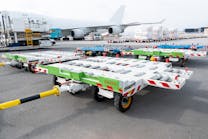HOPE, Ark. - In this small southwestern Arkansas city of 10,467 people, the Federal Emergency Management Agency is quietly disbursing the remnants of one of the agency's staggering failures.
Sixteen months ago, FEMA signed a $25,000-per-month lease with the city of Hope to take over part of Hope Municipal Airport. Since then, the federal agency has trucked in, one by one, the post-hurricane temporary housing units along the Gulf Coast known unaffectionately as "FEMA trailers."
The birthplace of former President Bill Clinton, Hope is now host to the world's largest trailer park - a 453-acre swath of land filled with 12,000 travel trailers and 8,400 mobile homes. Once known for growing watermelons, Hope now has a new industry: disaster relief.
Asked for directions to the airport on a recent afternoon, a waitress at a restaurant here smiles. "You mean you're looking for FEMA?" she asks.
It's not the first time she's been asked for directions. As many as 100 people a day now drive two-lane U.S. 278 toward Hope Municipal Airport. They're here to get in on the final stage of the $2.6 billion FEMA program that purchased travel trailers for temporary-housing units in the devastating wakes of hurricanes Katrina and Rita.
In the rush to respond to housing shortages along the Gulf Coast, FEMA bought thousands of travel trailers from the lots of dealerships across the country at an average price of $20,000. Some made it to the driveways of those whose homes were destroyed in the storms. Others were never delivered beyond government warehouses.
Now, with an enormous surplus of these FEMA trailers, the federal government has begun to auction them off in batches of 300 through the General Service Administration's Web site, gsaauctions.gov.
Already, 1,700 travel trailers and 900 mobile homes have been sold in previous auctions. Bidding on the current batch ends Monday, with more groups of 300 to be added in the coming months.
"Obviously, as these trailers come back, our sites are getting full around the country," says Deborah Wing, a FEMA spokeswoman in Washington. "We need to auction off those we no longer have a use for."
Wing says FEMA trailers sell for about $5,500 on average - about one-fourth the price the government paid less than two years ago.
Standing along a row of about 30 travel trailers at Hope Municipal Airport, Charles Ashley, of Hot Springs, Ark., is searching for a deal. He points to the window of one of the units. "MSRP - $18,730," reads the writing from the dealership. This trailer was hauled across the country but never made its way to the hurricane victims who needed shelter.
In fact, the user manuals are still in the appliances.
Ashley grins as he inspects the deal. "The government bought a lot of stuff, and they didn't use it, see," he says. "Now they have to get rid of all these. It's good for me, but it's bad, you know. Some of these trailers never made it down there to the Gulf Coast."
He points toward the highway. "You can drive down the road there for a mile," Ashley says. "All you'll see on your left, the whole way, are trailers, trailers, trailers."
Trailer trashed
Most of the travel trailers up for auction have something wrong with them: They're missing batteries or propane tanks. Some have foul odors. Others have stains on the carpets.
The hurricane victims who lived in the units caused some of the damage - but not all of it. According to an oversight report provided to Congress last year, San Francisco-based Bechtel, the company FEMA contracted to distribute trailers in Mississippi, "cannibalized" many units in violation of its contract, effectively voiding manufacturer warranties that would have covered damage to many of the trailers now up for sale.
According to the official line from FEMA's Washington headquarters, only trailers requiring $1,500 or more in repairs are on the auction block. But it's not that simple among the rows and rows of temporary homes in Arkansas.
Jerry Hall, FEMA's site manager in Hope, drives his black Chevrolet Suburban around the government's massive trailer park on a recent afternoon. He points to a small white trailer with a square window on each side.
"Those are the Plain Janes, the spec trailers," Hall explains.
Before Katrina, FEMA would distribute these mass-produced trailers as temporary housing units. They all use the same parts and are easy to repair and reuse.
Ill-equipped for the scale of devastation in 2005, however, FEMA didn't have time to produce thousands of new Plain Janes. Instead, the agency purchased anything it could, including luxury travel trailers with surround-sound audio systems and slide-out compartments that create a larger living space when parked.
While some of the trailers up for auction are Plain Janes, most are these high-end consumer models purchased from trailer lots at retail prices.
"The luxury slide-out units weren't worth the trouble," Hall says.
Along the Gulf Coast, he says, it wasn't uncommon for one family to receive a Plain Jane and their neighbor to be given a $20,000 unit with the stickers still attached. Hurricane victims repeatedly called FEMA with requests for nicer digs, he says.
As a result, FEMA has stockpiled 8,400 mass-produced mobile homes on the northwest side of Hope Municipal Airport. For future disasters, the agency will distribute these identical housing units to everyone in need.
But that still leaves about 12,000 consumer travel trailers in Hope - and 46,000 nationwide - that need to be sold. And those numbers are only increasing as more and more trailers are returned to the government.
In fact, FEMA has so many trailers in Arkansas and other states that selling all of the units at once could bankrupt the nation's travel-trailer industry, admits the agency's spokeswoman.
"We don't want to flood the market," Wing says. "We're well aware of the economic effects selling these trailers could have."
Toxic homes?
Bankruptcy is exactly what the travel-trailer industry deserves, says Becky Gillette, co-chair of the Sierra Club's Mississippi chapter.
Last year, Gillette and her colleagues randomly tested air-quality conditions in some of the FEMA trailers distributed throughout the Gulf Coast. What they discovered : In 94 percent of the first 31 trailers tested, formaldehyde levels exceeded those recommended by the Occupational Safety and Health Administration. A second test of 52 trailers revealed 83 percent of those had excessive formaldehyde levels.
A colorless gas, formaldehyde is found in wood and glues in travel trailers. The gas can cause eye irritation and headaches, and in excessive levels, it can be toxic.
"The trailers are poorly designed and don't have adequate ventilation," Gillette says. "Every [travel trailer] brand we tested - and we tested 13 different brands - had at least some tests that were over the limits."
This high level of carcinogenic gas in travel trailers - whose air-quality standards are not regulated by the federal government - is a post-Katrina discovery, in part, because humid conditions in the South and the trailers' use as full-time living facilities may have exacerbated problems associated with formaldehyde in the building materials.
In August 2006, the Environmental Protection Agency began to test air quality in FEMA trailers. Although those test results are not yet available, FEMA has advised people living in travel trailers to increase ventilation, keep inside temperatures cool and lower humidity levels.
Given the potential danger, FEMA should destroy the trailers, not sell them, says Gillette.
"They are taking these trailers that they know are dangerous and pawning them off on unsuspecting people," she says.
Government deals
It's Mike and Pam Lemley's fourth trip to Hope. They've been making the 45-minute trip from their home in Fouke, Ark., to find a deal on a travel trailer to use on vacations.
"We go to several lakes in the area and would like to use the trailer there," says Mike Lemley, who carries a three-ring binder filled with printouts from the government's auction site.
They're walking in and out of the trailers, making notes as they open cabinet doors and inspect appliances.
The deal the Lemleys are looking for might not be in this batch of trailers, they admit, but eventually they'll find their vacation home at a rock-bottom price.
Pam Lemley says she's been hearing about trailers in Shreveport, La., on their way to the FEMA facility in Hope.
"They're brand new," she says, "never been lived in."
Then Pam Lemley shakes her head, finding humor in how she and her husband plan to take advantage of this unofficial federal subsidy.
"The government," she says, pausing. "Look at all the money they're spending. What a waste."
Copyright 2005 LexisNexis, a division of Reed Elsevier Inc. All rights reserved.
Terms and Conditions | Privacy Policy
News stories provided by third parties are not edited by "Site Publication" staff. For suggestions and comments, please click the Contact link at the bottom of this page.





